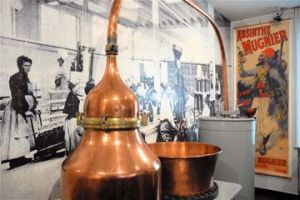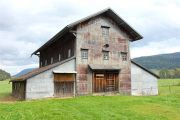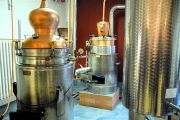 |

|
 Pontarlier Museum © T.Joly Pontarlier Museum © T.Joly

|
Legal again, coined “the Green Fairy”, absinthe is coming back into vogue. Two regions of France and Switzerland have created a tourist itinerary to learn more about the history and the production of this alcoholic drink.
[ Practical ]
Getting there
- By road
470 km from Paris on autoroutes A6, A31 and A36 till exit 4, then on N57 till Pontarlier.
- By train
TGV Lyria from Paris Gare de Lyon to Frasnes, then TER till Pontarlier. The journey takes three hours.
Lodging
- Pontarlier
Hôtel Saint-Pierre
Ibis
Hôtel Campanile
-Switzerland
Hôtel de l’Aigle, in Couvet
Restaurants
- Pontarlier
L’Alchimie
La Pinte Comtoise
Les Papillons
Brasserie de la Poste
Hôtel Saint Pierre
Pause déjeuner, in La Cluse-et-Mijoux
- Switzerland
Hôtel de l’Aigle, in Couvet
Chapeau de Napoléon, in Saint-Sulpice
Au Grenier Gourmand, in Travers
Getting around
It is necessary to have a car to follow the Absinthe Trail
Absinthiades
2014 edition on October 4th and 5th
Musée de Pontarlier
Open Saturday and Sunday from 2pm to 6pm, Monday, Wednesday, Thirsday and Friday from 10am to noon and from 2pm to 6pm.
Tel : 0381388214
www.ville-pontarlier.com
Absintherie du Père François
Tel : 00 / 41328612318
www.absintherie.ch
Distillerie Les Fils d’Emile Pernot
Tel : 0381390428
www.emilepernot.fr
Distillerie Pierre Guy
Tel : 0381390470
www.pontarlier-anis.com
Information
- Franche Comté Tourist Office
Tel : 0381250800
www.franche-comte.org
- Pontarlier Tourist Office
Tel : 0381464833
www.pontarlier.org
- Neuchâtelois / Val de Travers Tourist Office
Tel : 00 / 41328896896
www.neuchateltourisme.ch
- Absinthe Trail
www.routedelabsinthe.com
An herb and anise-based spirit containing 45 to 72% alcohol, absinthe was highly appreciated by 19th-century and early 20th-century bohemian artists and writers such as Baudelaire, Van Gogh and Verlaine who said it enhanced the creative energies and nicknamed it "the Green Fairy". However, temperance leagues claimed it provoked madness in regular drinkers and it was banned for almost a century.
 Elaborate ritual Elaborate ritual
Now legal again, absinthe in back in liquor stores and bars but its dodgy reputation as an addictive, hallucinatory and mind-altering drink continues to this day. The elaborate and intriguing absinthe service ritual also contributes to the aura of mystery still enshrouding it. First, this potent spirit is poured into a special absinthe glass with a slotted spoon place on top. Then, a sugar cube is placed on the spoon and ice water is dripped onto it. Like pastis, absinthe is indeed diluted with water three to five times its volume and adding water is an important part of the final taste since it allows the herbs to "blossom" and bring out many of the flavours originally overpowered by the anise.
 Born in Switzerland Born in Switzerland
If absinthe is nowadays produced in a dozen of countries worldwide, its historical cradle is located in two adjacent French and Swiss regions. Pontarlier and its surroundings, in the Doubs department, in eastern France. The Val de Travers, between the border and Neuchâtel, in Switzerland.
Everybody agree to date the birth of absinthe around 1770 in the Val de Travers. However, depending on which side of the border you are, the story is not the same when it comes to the respective role played by a Swiss woman, Henriette Henriod, and a French itinerant doctor, Pierre Ordinaire.
First a medicinal elixir, it quickly became a popular aperitif after a certain Major Dubied acquired the formula and opened a distillery in 1797 at Couvert, in the Val de Travers.
 Fifty km long trail Fifty km long trail
Then, in 1805, in order to avoid paying high export taxes, he send his son in law Henri-Louis Pernod to open a distillery in France, in Pontarlier, where a century later 25 distilleries manufactured yearly 10 millions litres of absinthe, half of the total national production !!!
So, these two regions got the idea to create an Absinthe Trail both to promote this drink and to attract amateurs and tourists willing to learn more about it. Roughly 50 km long, it lists and passes by towns and villages where are found museums and places evoking its history, distilleries, liquor stores and bars selling this drink, shops offering absinthe-based products and restaurants serving dishes featuring absinthe.
In France, this road starts at Pontarlier where each year during the first weekend of October amateurs from all over the world gather together on the occasion of the Absinthiades.
 The best European absinthe The best European absinthe
An event whose highlight is a competition rewarding the best European absinthe. But it also features exhibitions, conferences, shows and an absinthe memorabilia fair. In July, the town also hosts a “Fête de l’Absinthe” celebrating the herb harvest and featuring tasting, brass band parades, ancient crafts demonstrations, exhibitions focusing on absinthe history and concerts. Outside these weekends, tourists can visit two distilleries perpetuating the tradition and offering guided tour and tasting. The Distillerie Guy, right in the city centre, and the Distillery Emile Pernot that is located a few kilometres away, at la Cluse-et-Mijoux, at the feet of the impressive Joux Castle that sits on a bluff commanding the mountain pass leading to Switzerland.

 Pontarlier Museum© T.Joly Pontarlier Museum© T.Joly
|
 Various recipes Various recipes
Another not-t-be-missed place is the town’s museum where several rooms retraces the history of absinthe, explain the reasons why it was banned and the production process through copper stills, bottles, glasses, tools, old photographs, advertising posters, catalogues, books, newspapers and propaganda from the anti-absinthe temperance movement.
Depending on the distillers’ recipes, absinthe is green or white and up to 15 herbs can be used to make it. The most common are the Roman wormwood (or small wormwood), the green anise, the fennel, the hyssop, the lemon balm and the common wormwood (or tall wormwood). It’s a chemical, compound of the latter, the Thujone, that was blamed for absinthe mind-altering effects and its quantity is now limited to 35 mg per litre.
So, today, distilleries use less than one kilogramme of common wormwood per 100 litres instead of 6 – 7 kilogrammes in the past.

 Absinthe drying barn in Boveresse © T.Joly Absinthe drying barn in Boveresse © T.Joly
|
 More distilleries in Switzerland More distilleries in Switzerland
As a result very few farms cultivate this herb and the only one open to the public in France is the GAEC de l’Absinthe, situated at Grange-Narboz, 5 km from Pontarlier. But its main activity is milk production.
In Switzerland, a wormwood growers association offers field tours on request but the herb is only cultivated on about 3 000 m2 while it covered 300 ha around Boveresse at the beginning of the 20th century. Hence the size of the former absinthe drying barn you can see in this village. It now houses an exhibition on the agricultural activities that used to go on in the area.
Yet, Switzerland counts many more distilleries than France. In spite of the ban, production never ceased in the Val de Travers as dozens of bootleggers made absinthe the clandestine way and several of them now operate their stills legally.

 Absintherie Le Père François © T.Joly Absintherie Le Père François © T.Joly
|
 Astonishing collection Astonishing collection
A few newcomers joined them and there are distilleries in almost every village, big ones with an established international reputation, like Kübler, as well as micro-producers. Among the latter, make sure to pay a visit to Le Père François because it also boasts a very interesting museum housing an astonishing collection of absinthe related objects, posters, postcards and bottles. It is situated in Môtiers where the Mascarons museum also has a room devoted to absinthe. In addition, an Absinthe House comprising interpretation centre, tasting rooms and shop should be inaugurated in the same town in 2014.
September 10, 2014
Thierry Joly 

|



